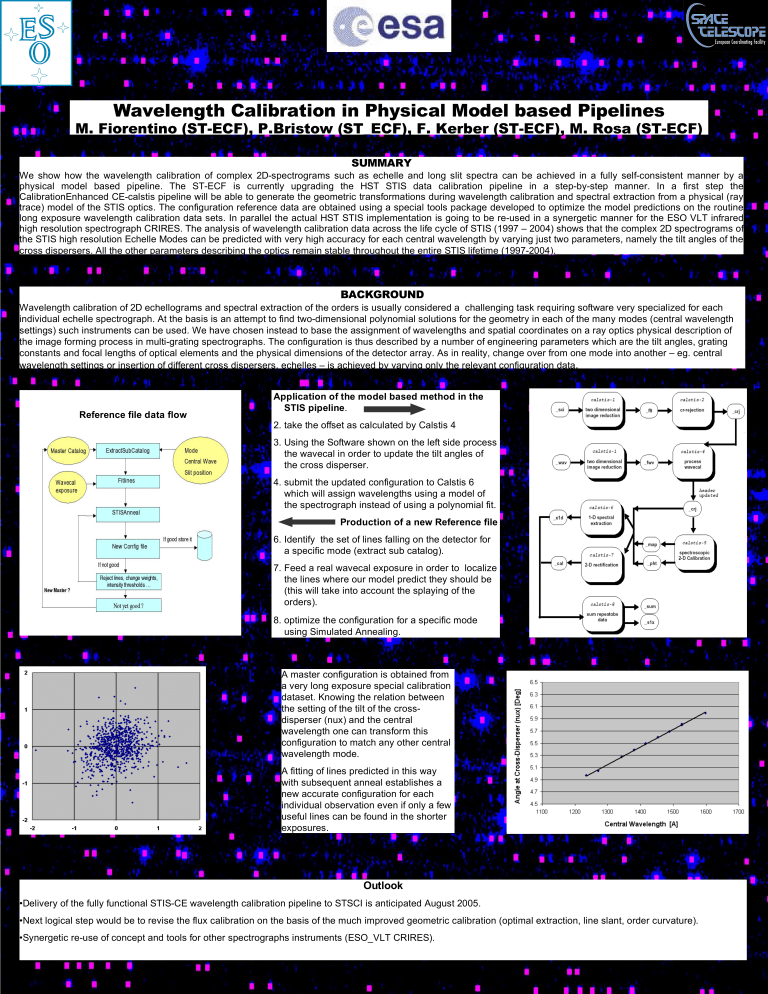Wavelength Calibration in Physical Model based Pipelines SUMMARY

Wavelength Calibration in Physical Model based Pipelines
M. Fiorentino (ST-ECF), P.Bristow (ST_ECF), F. Kerber (ST-ECF), M. Rosa (ST-ECF)
SUMMARY
We show how the wavelength calibration of complex 2D-spectrograms such as echelle and long slit spectra can be achieved in a fully self-consistent manner by a physical model based pipeline. The ST-ECF is currently upgrading the HST STIS data calibration pipeline in a step-by-step manner. In a first step the
CalibrationEnhanced CE-calstis pipeline will be able to generate the geometric transformations during wavelength calibration and spectral extraction from a physical (ray trace) model of the STIS optics. The configuration reference data are obtained using a special tools package developed to optimize the model predictions on the routine long exposure wavelength calibration data sets. In parallel the actual HST STIS implementation is going to be re-used in a synergetic manner for the ESO VLT infrared high resolution spectrograph CRIRES. The analysis of wavelength calibration data across the life cycle of STIS (1997 – 2004) shows that the complex 2D spectrograms of the STIS high resolution Echelle Modes can be predicted with very high accuracy for each central wavelength by varying just two parameters, namely the tilt angles of the cross dispersers. All the other parameters describing the optics remain stable throughout the entire STIS lifetime (1997-2004).
BACKGROUND
Wavelength calibration of 2D echellograms and spectral extraction of the orders is usually considered a challenging task requiring software very specialized for each individual echelle spectrograph. At the basis is an attempt to find two-dimensional polynomial solutions for the geometry in each of the many modes (central wavelength settings) such instruments can be used. We have chosen instead to base the assignment of wavelengths and spatial coordinates on a ray optics physical description of the image forming process in multi-grating spectrographs. The configuration is thus described by a number of engineering parameters which are the tilt angles, grating constants and focal lengths of optical elements and the physical dimensions of the detector array. As in reality, change over from one mode into another – eg. central wavelength settings or insertion of different cross dispersers, echelles – is achieved by varying only the relevant configuration data .
Reference file data flow
Reference Files Data Flow
Application of the model based method in the
STIS pipeline
.
2. take the offset as calculated by Calstis 4
3. Using the Software shown on the left side process the wavecal in order to update the tilt angles of the cross disperser.
4. submit the updated configuration to Calstis 6 which will assign wavelengths using a model of the spectrograph instead of using a polynomial fit.
Production of a new Reference file
6. Identify the set of lines falling on the detector for a specific mode (extract sub catalog).
7. Feed a real wavecal exposure in order to localize the lines where our model predict they should be
(this will take into account the splaying of the orders).
8. optimize the configuration for a specific mode using Simulated Annealing.
A master configuration is obtained from a very long exposure special calibration dataset. Knowing the relation between the setting of the tilt of the crossdisperser (nux) and the central wavelength one can transform this configuration to match any other central wavelength mode.
A fitting of lines predicted in this way with subsequent anneal establishes a new accurate configuration for each individual observation even if only a few useful lines can be found in the shorter exposures.
Outlook
•Delivery of the fully functional STIS-CE wavelength calibration pipeline to STSCI is anticipated August 2005.
•Next logical step would be to revise the flux calibration on the basis of the much improved geometric calibration (optimal extraction, line slant, order curvature).
•Synergetic re-use of concept and tools for other spectrographs instruments (ESO_VLT CRIRES).






